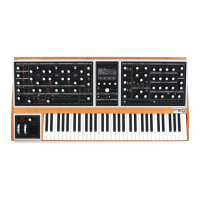56
OUTPUT (Continued)
UNDERSTANDING INSERTS
Inserts are unique in that they can function as both outputs and inputs at the same time. As outputs,
they provide a way of allowing each Synth to have its own dedicated output - either for recording and
monitoring purposes, or to independently access an external effect processor such as a stereo chorus
unit. The inserts also provide an input path, or return, from such an external processor. The monaural
output from an external processor is returned to the same insert jack it was sent from, using a 1/4” TRS
to dual 1/4” TS insert cable. For an external processor with a monaural input and a stereo output, Moog
One can receive the return signals using an adjacent pair of inserts. Odd numbered inserts (1, 3) merge
the return signal to the MAIN L buss, and even numbered insert (2, 4) merge the return signal to the
MAIN R bus. In this way, a monaural signal sent to an external processor can return in stereo using a
pair of adjacent insert points (1 & 2 or 3 & 4). So the monaural signal sent via INSERT 1 can be returned
in stereo using INSERT 1 and INSERT 2. Further, these adjacent pairs are normalled, so that if nothing
is connected to INSERT 2, the monaural return signal arriving at INSERT 1 will be applied to both the
MAIN L and MAIN R busses. The same scenario applies to INSERT 3 and INSERT 4.
Technically, each of the four inserts relies on a single 1/4” TRS jack wired as both a send and a return.
The Tip of this Tip/Ring/Sleeve jack is wired as the Send; the signal is then returned to Moog One
via the Ring connection of the Tip/Ring/Sleeve jack. Most often, an insert jack will be used with a
Y-Conguration Insert Cable (1/4” TRS to dual 1/4” TS) to achieve this functionality.
NOTE: When active, the onboard Synth Effect is applied to each Synth before its signal reaches the
output (Tip) of the insert jack.

